
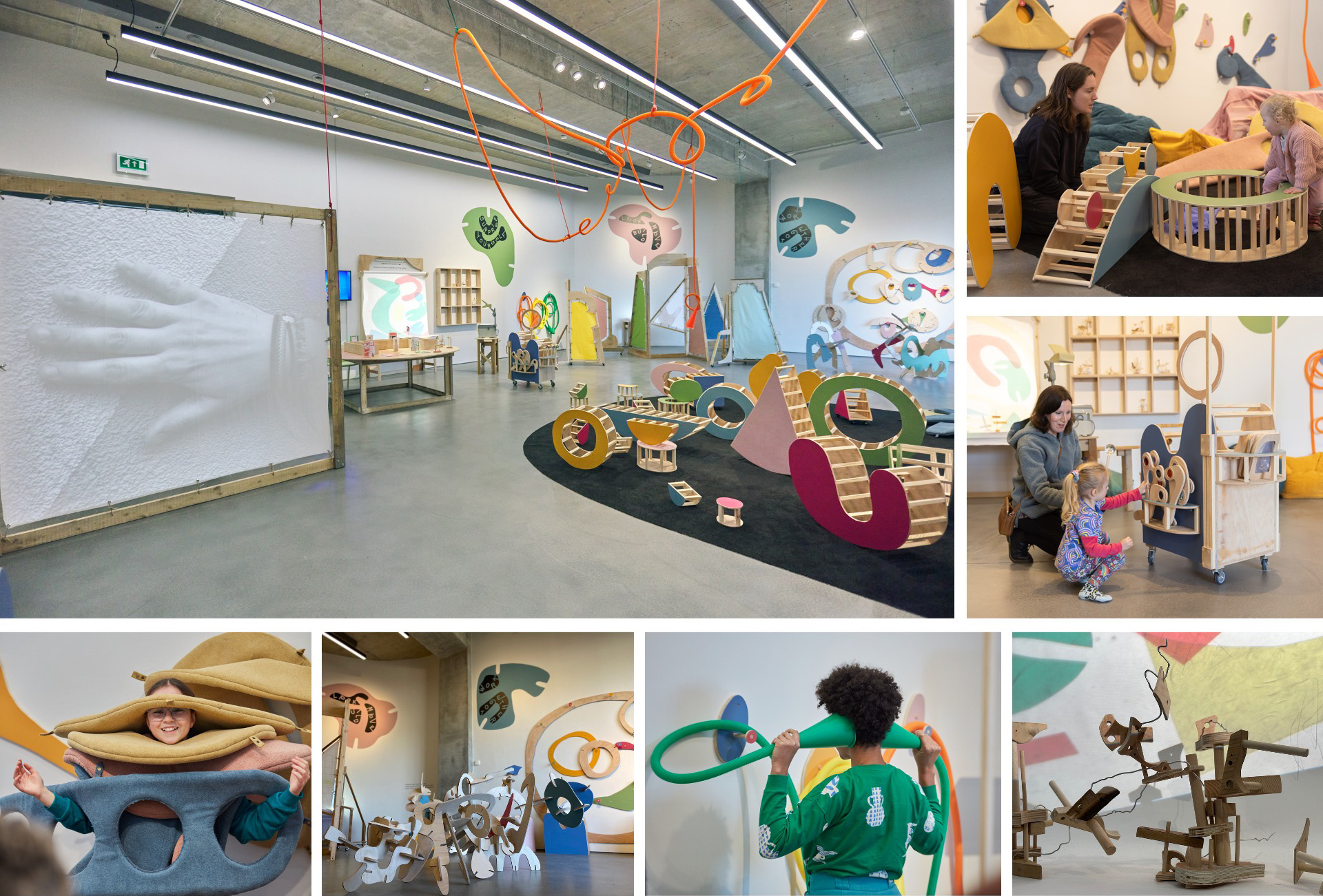
Image credits: Hugh Fox, Rob Harris and Leap Then Look
Play Interact Explore is a unique exhibition of interactive artworks and resources at Towner Eastbourne, developed in collaboration with four community settings in Eastbourne and Brighton.
The exhibition explores the possibilities of play, collaboration and material exploration in cross-disciplinary art practice, and features several large, tactile sculptural objects, touchable artworks and colourful assemblages, creating a lively, exciting and curiosity-filled space designed to support and encourage visitors of all types to take part in playful exploration and critical thought through making.
This exhibition and wider project engages communities and groups in multidisciplinary collaborative practice as a new approach to art and exhibition-making.
The project has been our most ambitious to date and brought together many of the ideas and approaches we have been exploring over the past few years. What it allowed us to do was spend time researching and developing physical objects, art works and spaces that would be richly interactive, in part due to the series of practical collaborative workshops we ran with four community settings. In these workshops we brought partially developed ideas, materials and constructions and invited participants to join us in playing with, and exploring their possibilities, sometimes watching and recording, sometimes making alongside one another and chatting. Being able to work in this way and reflect on our experiences and our participants' responses allowed us to create a space which we felt was full of possibilities and would provide a welcoming, exciting and accessible environment for many people for whom art galleries are not a place they necessarily feel at home in. The result was an exhibition where every part could be touched, picked up, moved around and joined together. We created different layers and levels, with the hope of allowing people of different ages, experiences, physical and neuro-differences to explore the space in ways they felt engaging.

To accompany the exhibition we worked with WorkForm design studio to create a series of three booklets which offer prompts and ways of engaging with the artworks and environments within the space as well as thoughts, ideas and images that we have found central to the development of the project. This design work was carried through into the exhibition with large vinyls on the walls offering friendly prompts to visitors.
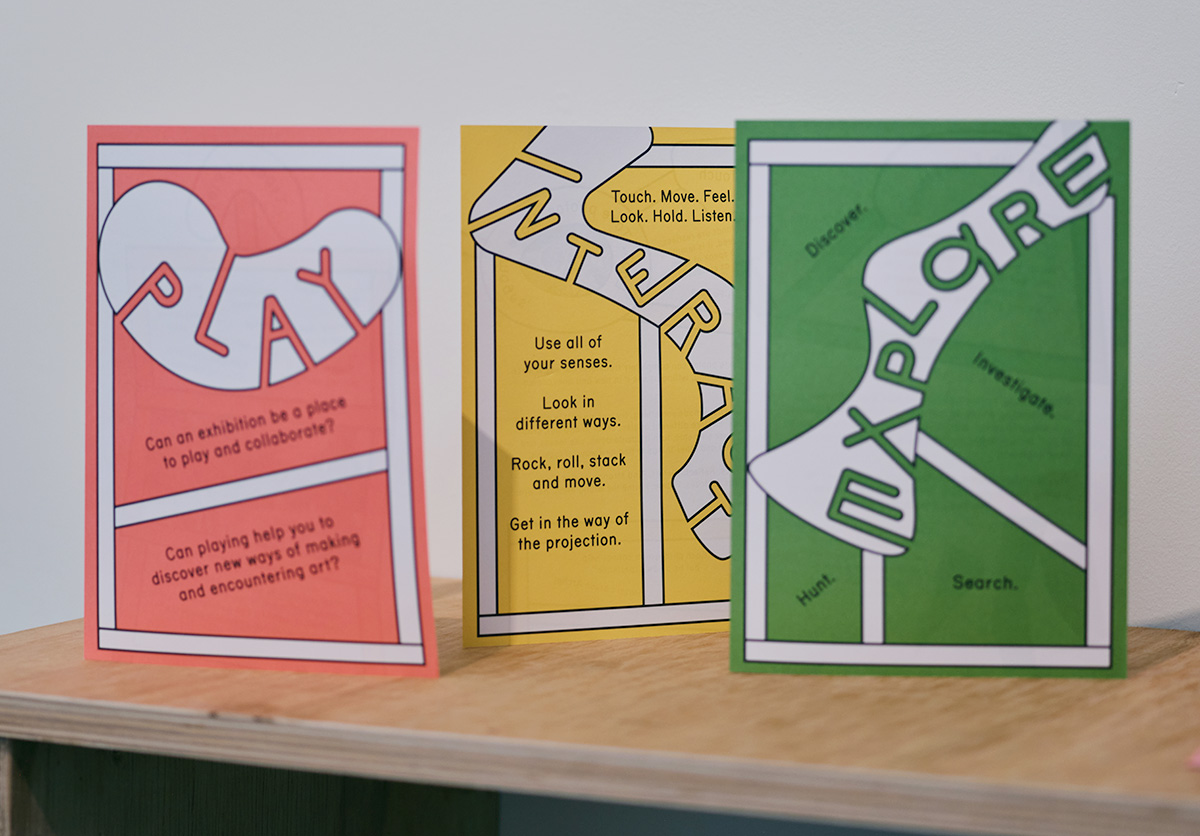

Download Play Interact Explore Exhibition booklets here
COLOUR
BLACK AND WHITE
Associate Artists

Each week during the exhibition one of our four associate artists, Chahine Felahi, Pei-Chi Lee, Becky Horne and Eva Jonas spent time in the space, observing, intervening and experimenting in response to the installation. They each ran a specially devised workshop for a community group and created artistic interventions in the space each Sunday. For us, these sensitive, thoughtful and provocative interventions opened up new lines of thought and practice, subtly transforming the space and its possibilities. They were supported to devise and deliver a community workshop each week which reflected their diverse interests and respective analogue film, object making, mapping and movement practices. These workshops offered participants unexpected ways of engaging with the space and the art works within it.
“Thank you for the most amazing workshop on Friday, the students are still talking about it this morning. It was such an engaging, inclusive, calm approach which ensured all of the young people could access it at their level. ” (Tania Banks, Downs View Link College teacher)
Exhibition Programme

Image credits: Hugh Fox and Leap Then Look
Throughout the exhibition run there was a public programme of workshops for various groups including schools and community settings, an in-conversation artists talk and professional development workshop. These workshops offered dedicated time and space in the exhibition for groups who might not otherwise feel able to attend during public opening times and was an important principle for us in making sure the exhibition was accessible to these groups. A Collaborative Practice workshop, run for professionals and other interested people was an opportunity for us to explore the development of the project and to explore a number of collaborative activities and games which would prompt conversations about the importance of collective making, communication and interaction.
In Conversation
An In Conversation event with Lucy Cran and Bill Leslie (Leap Then Look) and Dr Rebecca Sinker was held at Towner Eastbourne on 25th February 2022. Situating the exhibition within a larger field of contemporary art practice, and renewed interests in interaction, participation, play and public space. This talk explored both the creation of Play Interact Explore and how it developed alongside our wider practice combining concerns with collaborative and interdisciplinary art practice, pedagogy and participation.
A recording of the artists talk is available on request. Please email Esther.Collins@townereastbourne.org.uk
Developing Play Interact Explore
West Rise Junior School
During the development phase we worked in partnership with four local community settings; West Rise Junior School in Eastbourne, the Arts in Mind project at Towner Eastbourne, Downs View Link College in Brighton and children and families supported by the Brighton and Hove Foster Service.

Over the past four years we have built a strong relationship with West Rise Junior School and their creative ethos though a long-term project funded by Arts Council England and South Downs National Park where we worked with children and staff to explore the creative potential of a large area of local marshland. The four workshops we ran as part of Play Interact Explore were an extension of this process. Children had expressed to us the importance of play, open space, freedom and responsibility in their understanding of art and the outdoors. We brought Sculpture Playground, our interactive set of rockable, rollable, stackable sculptures to the school and invited groups of children to be our research and testing team. Adding other elements like rope, bicycle wheels and fabric we asked children to explore the sculptures extending them in any way they chose. We observed and recorded these interactions during the session and then discussed with the children what elements they felt were successful and how they could be developed. We drew pictures together of new objects and talked about what else the children thought would be fun and exciting to have in the exhibition.
One workshop involved the children building a fort, dressing in sheets and staging a series of running battles with drumming, chants and games of chase. Others produced elaborate structures, built and rebuilt, and used an outdoor roundhouse structure to support ropes to make criss-cross patterns, swings and collaborative games.
What emerged from these sessions was the importance of play for older primary school children (opportunities for which tend to diminish as children get older), of loose parts and elements which can be connected and recombined, and which have an excess of possibilities for cause and effect, building and construction, and imaginative play.
Downs View Link College
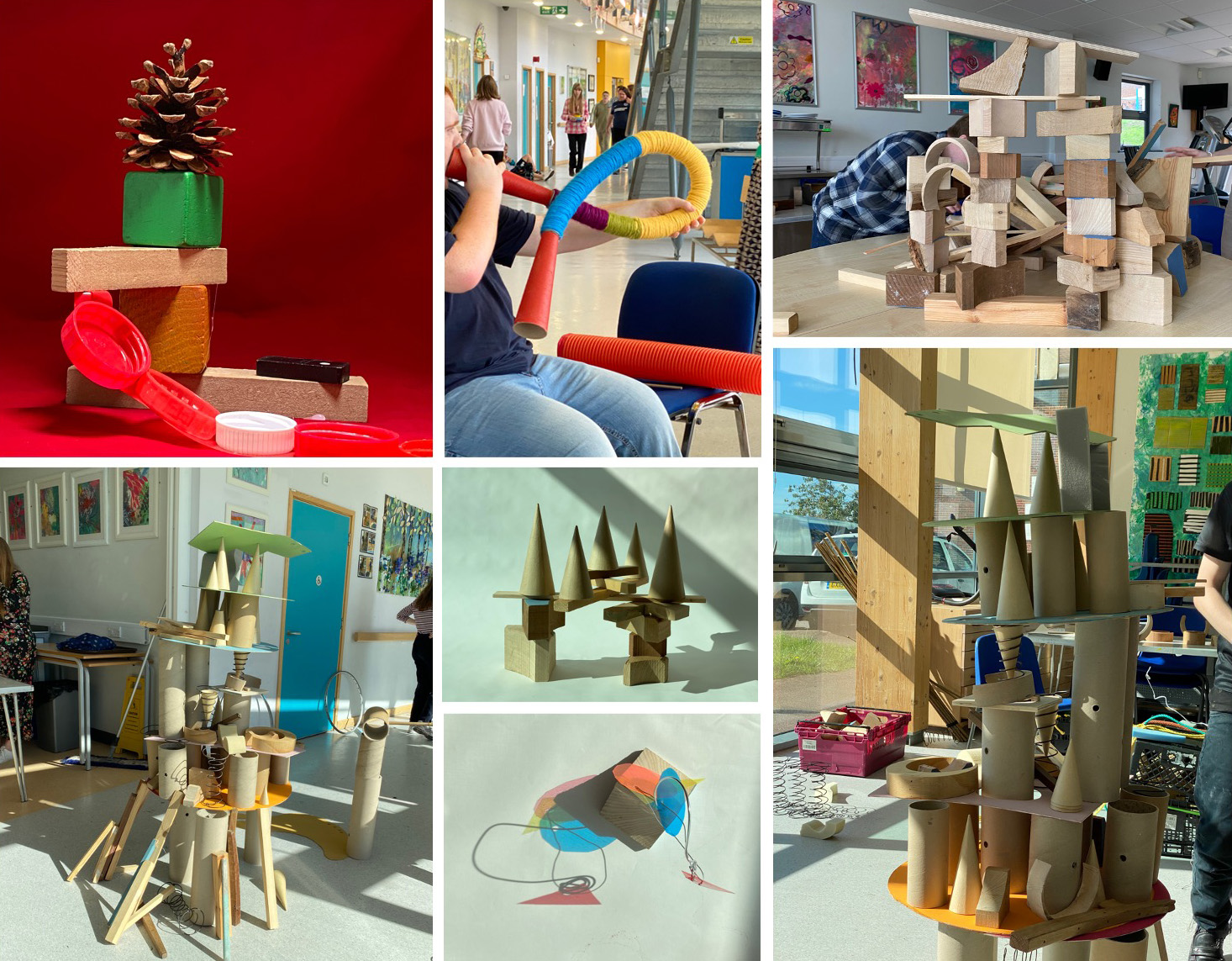
Another setting with which we had a pre-existing relationship, was Downs View Link College, a school for young people aged 16-19 who have special educational needs and disabilities. In 2019, we ran a series of sculpture and photography workshops as part of the Photoworks and Project Artworks photography project In-Focus. For Play Interact Explore we worked with up to four class groups each week who joined the sessions at different points and stayed for as long as they wished. We created sculptures from offcuts of wood, large cardboard tubes, wire, coloured acetate and other scrap materials. We also created a set of sound tubes that the young people could use to speak, sing and listen through. What was wonderful about this setting was that we met young people with all sorts of different presences, desires and abilities. Some were initially cautious, others were immediately drawn to different elements, some craved space and simplicity, others were excited by interpersonal communication, some responded to sensory elements, sounds and textures, others worked in small groups playing cause and effect games, building elaborate towers and knocking them over.
These experiences showed us that to create a space that welcomed and excited such a broad cohort of individuals needed to offer many different forms of engagement and appeal to all of the senses. We also saw the need for different levels – tables, beanbags, tall structures for people who don’t like to sit – and spaces where young people could feel safe and calm and could take their time observing and then interacting with objects which they could move over to themselves or which could be brought over and offered to them.
Arts in Mind
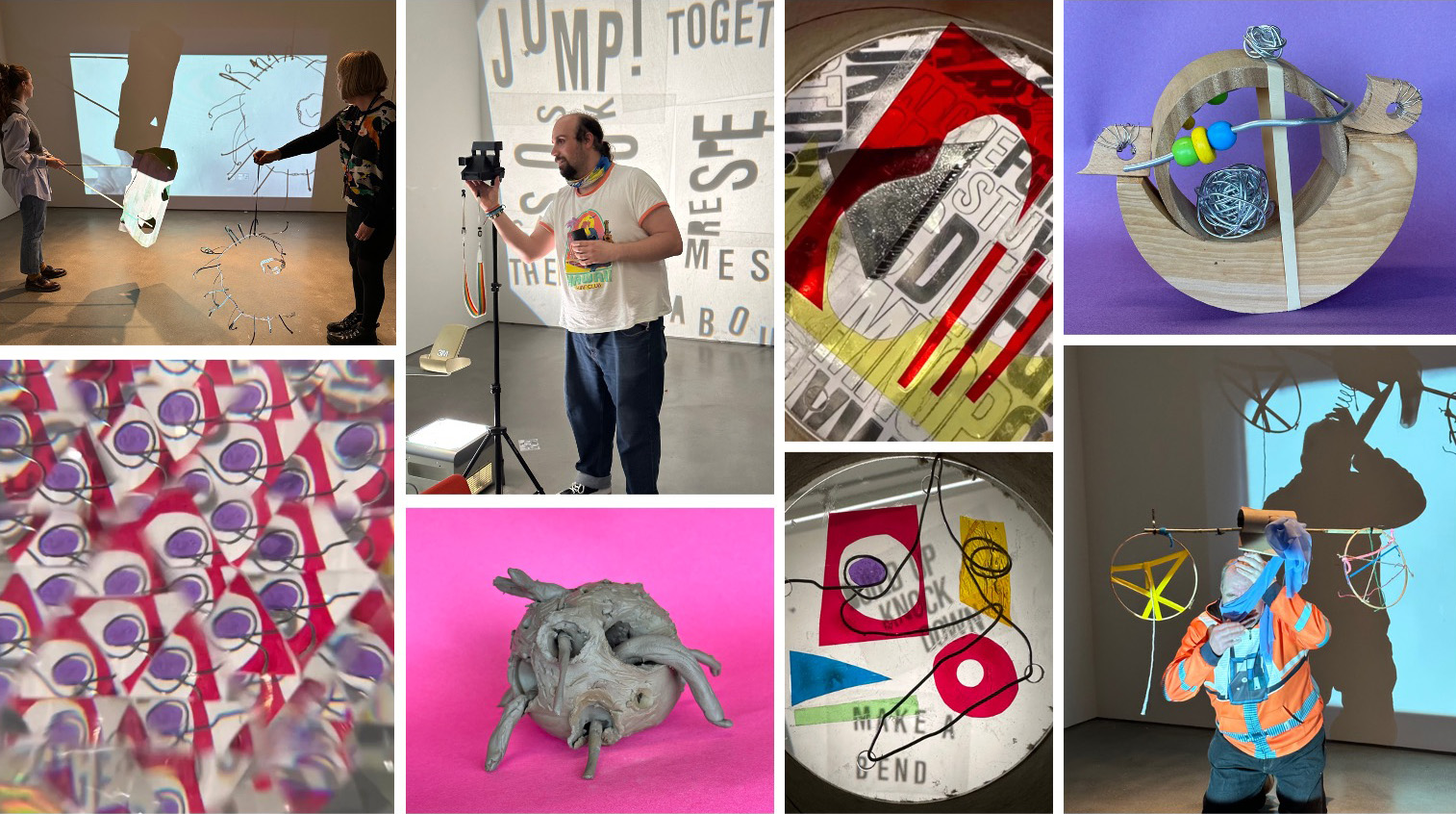
Arts in Mind is a long running fortnightly supported art studio setting for adults which aims to nurture positive mental health.
What was important to this group was plenty of time around the edges to talk, be together and make their own work. There was a particular pace to these sessions with responses often emerging through careful, thoughtful engagement with ideas and materials. The group were also largely more comfortable working at tables, and enjoyed exploring movement, visual effects created with projections and lenses and building imaginative play structures using clay and scrap materials.
These sessions prompted the questions; how do adults play? How could a space be created that accounted for differences in pace and the necessity or desire for contextual framing? What do adults need to feel comfortable in a space which is made up of broad and playful invitations? How can language and text be used to indicate possibilities and starting points, and how can the ideas and concepts that underpin the importance of play and exploration be articulated and supported for adults as much as for children?
Children and their foster families
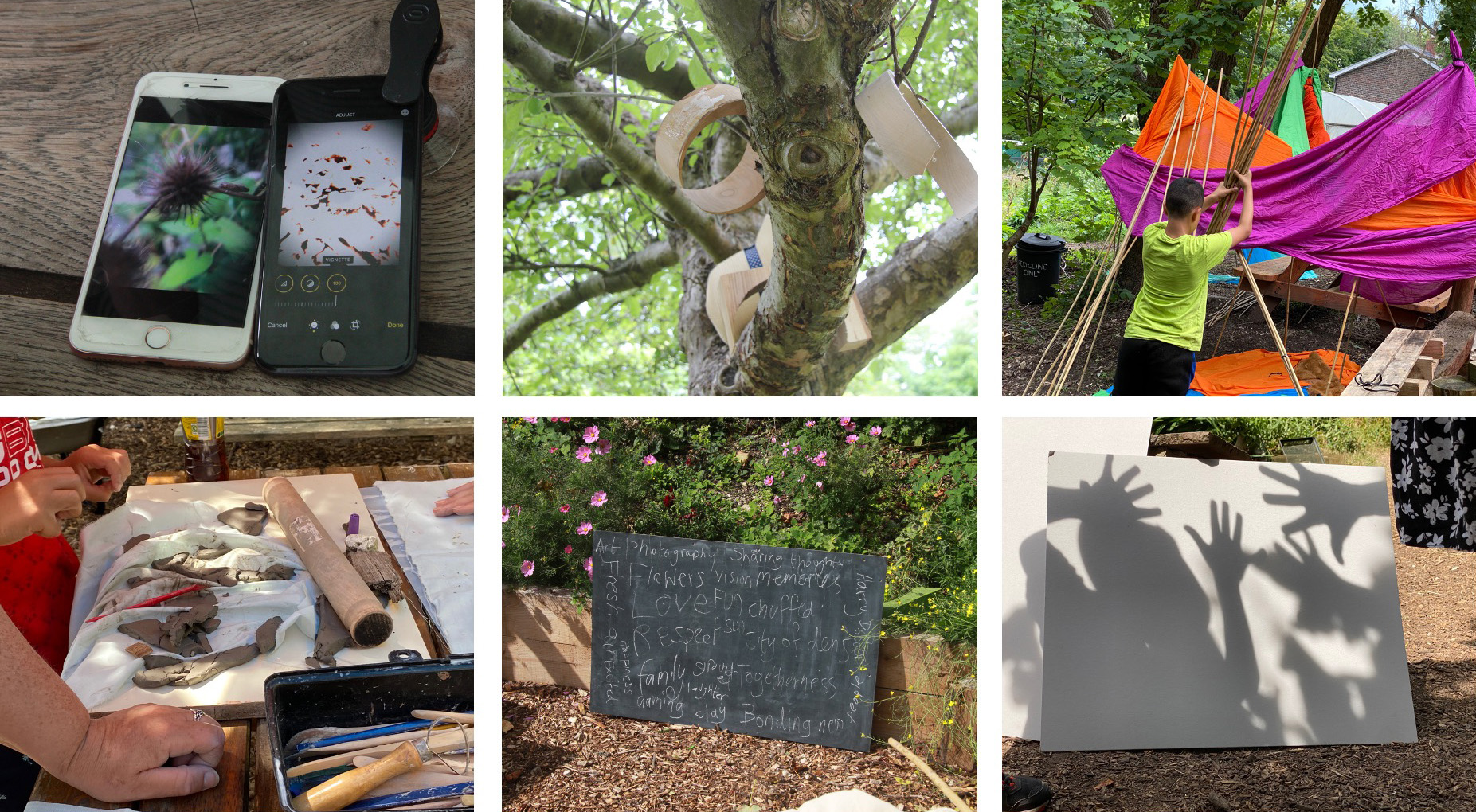
We also ran a series of workshops for children, their foster families and birth parents in Brighton and Hove in partnership with the Brighton and Hove Foster Service. These workshops provided space and creative opportunities which aimed to involve families in group activities; working with clay, building large structures from bamboo, listening activities, experimenting with photography, and exploring the environment together. These workshops happened in the Moulsecoomb Forest Garden, an outdoor community growing space on a steep hill, surrounded by trees with paths connecting different areas of planting. We have worked here with foster families for the past few years and have seen how important the space itself is for the participants.
Made up of many different small areas, full of plants and trees, the space offers places to stroll, run, hide behind, climb and swing from, which contribute to a sense of openness with lots of things to do but no pressure to do things in any particular way.
During the workshops we added our own invitations to look in different ways, work together to explore and make interventions; small sculptures to leave for the next people who came along to see, temporary structures built in collaboration, and different ways of looking at and capturing elements of the landscape and our presence within it. We tried to make the activities and materials that we brought straight-forward and open. Invitations rather than imperatives, so that participants could work their ways through the sessions as they pleased with support where needed and encouragement to take things in any direction they wanted.
The space seemed to reduce anxiety, gave children and adults space to sit, chat, play and run without there being any strict rules or prohibitions beyond those of looking after yourself and one another and taking care of the environment. A paper about these workshops, discussing the effectiveness of our approach, written by senior social worker Rebecca Watts will be presented this year at international conference EuSARF (The European Scientific Association on Residential and Family Care for Children and Adolescents).
Play Interact Explore was supported using public funding by the National Lottery through Arts Council England The National Lottery Community Fund , Towner Eastbourne, Brighton CCA & University of Brighton, a Communities Fund grant from Brighton & Hove City Council and West Rise Junior School.

